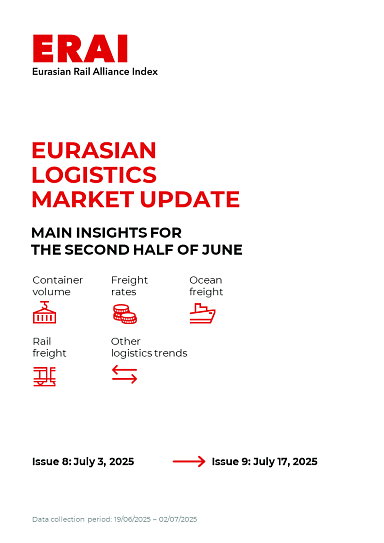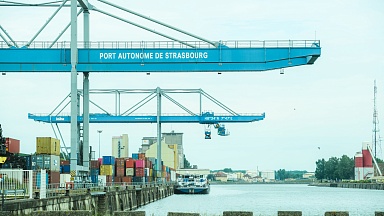When using, citing, or distributing the materials from this report, it is mandatory to reference the ERAI portal and include the webpage address https://index1520.com as the source of information.
China-Europe logistics market
Demand outlook
-
China’s exports are showing signs of recovery. In June, export orders improved, partly due to easing U.S. tariff pressure. A key driver has been the automotive sector: in May, Chinese exports of plug-in hybrids (PHEVs) to the EU surged 600% YoY, as these models are not subject to higher tariffs [SCMP]. Overall PHEV exports in the first five months of 2025 grew 140% YoY. However, domestic demand in China remains sluggish. Deflation persists, and corporate profits dropped sharply in May (-9.1%). In response, authorities are expanding consumption stimulus measures through subsidies, trade-in incentives, and credit programs. Notably, the People’s Bank of China is activating a previously announced ¥500 billion ($69.7 billion) refinancing quota [SCMP].
-
The June PMI suggests a weak but steady recovery in eurozone business activity. For the first time in 3.5 years, Germany recorded growth in export orders, while the overall decline in the region was the smallest since April 2022 [S&P Global]. Falling inflation and improving business sentiment are creating conditions for a trade rebound. Against this backdrop, expectations for monetary easing are rising — analysts now forecast another ECB rate cut in September [Reuters], which would also further support external economic activity.
-
Strong demand for Asia—Europe ocean freight persists. According to BIMCO, the improving macroeconomic environment in the EU—driven by falling inflation and a rebound in consumer spending—is supporting this trend [JOC]. DHL Global Forwarding expects the start of a full-fledged peak season beginning in July.
Freight rate trends
-
The average rail freight rate on the China—Europe route (SOC) remained virtually unchanged over the past month, with rates ranging from $5 000 (Chengdu) to $6 850/FEU (Shenzhen).
-
The Shanghai—Rotterdam WCI rose by 1% last week, reaching $3 204/FEU (+48% MoM, —56% YoY) [Drewry].
UPDATE: As of the evening of July 3, 2025, the latest WCI Shanghai-Rotterdam reading has risen by 8% WoW, reaching $3 468/FEU.
CMA CGM and ONE are quoting rates around $3 400/FEU for the first half of July, while offers above $4 000/FEU were still seen in late June. Higher levels (~$4 000) are already being quoted for the second half of July [GeekYum]. Stable demand is providing short-term support for rates, which could continue to rise and peak in July [Flexport]. Equipment shortages, blank sailings, and port congestion are adding further upward pressure on pricing in the near term. On the other hand, the Gemini alliance (HPL and Maersk) is maintaining a zero blank sailing strategy, which could draw the market into another round of rate wars [Linerlytica]. -
However, futures pricing points to moderately bearish expectations and a downward correction starting in July. According to the Shanghai Futures Exchange, rates on the Asia—Europe route are expected to gradually decline from current levels to around $1 800/FEU by the end of October.
Other trends
-
Chongqing is positioning itself as a «rail-based Suez Canal» — a key transit hub between Southeast Asia and Europe. The ASEAN Express route, launched in October 2024, highlights China’s growing role as a land-based transit platform, increasingly linking its regional neighbors to overland trade corridors. As of April 2025, cargo volumes on this route reached ¥1.65 billion (~$229.6 million), with weekly departures now established [SCMP].
-
Meanwhile, German rail, industrial, and trade associations are urging the government to increase subsidies for rail infrastructure access by €75 million (to €350 million) in the 2025 budget, and to implement a reform of the rail tariff system [RailTarget]. Infrastructure charges rose by 16% in December 2024, and could increase by another 8–35% in December 2025. These rising costs are undermining the competitiveness of rail transport and could force operators to exit the market.
China-EAEU logistics market
Import and export trends
-
The St. Petersburg International Economic Forum took place from June 18 to 21, during which key messages about the current state of the Russian economy were shared. President Vladimir Putin stated that Russia’s GDP grew by 1.5% YoY over the first four months of the year. He also noted that, thanks to actions by the Bank of Russia and the government, inflation in the country has fallen below 10%. Elvira Nabiullina, current governor of the Bank of Russia, said that the central bank will begin lowering the key interest rate as inflation slows.
-
Deputy Prime Minister Vitaly Savelyev, speaking at the forum, said that the Ministry of Transport may be transformed into the Ministry of Infrastructure Development and Logistics. According to him, over the next 10–15 years, the sector will evolve from a purely transport-oriented model to a logistics-driven one, with greater emphasis on value-added services and high-value cargo.
-
Alexey Zabotkin, Deputy Chairman of the Bank of Russia, stated that the key rate could be cut by 100 bp at the July meeting. However, the central bank may choose to pause between cuts. He noted that inflation is expected to move toward the 4% target [Kommersant]. Meanwhile, the Eurasian Development Bank forecasts the key rate to reach 18% by the end of the year. Due to high interest rates and the strengthening ruble, Russia’s inflation is expected to slow to 7.5% in 2025, down from 9.5% in 2024. Analysts expect the ruble to weaken in the second half of the year, reaching 95 RUB/USD.
-
High interest rates are causing businesses to delay investment decisions, posing a risk to economic growth potential. However, the anticipated easing of monetary policy could have a positive impact on the Russia’s import volumes in Q3. In addition, experts continue to forecast the ruble weakening to 95–100 RUB/USD, which could encourage domestic exporters to increase shipments toward the end of the year.
-
According to FESCO, Russia’s container market contracted by 3.1% over the first five months of 2025. In May alone, the decline was 6.9% YoY. Imports fell by 5% YoY. Rail transit volumes overall dropped by 4%. Domestic container volumes declined by 13% YoY. Container exports, on the other hand, grew by 8% YoY. The strongest growth continues to come from export shipments via land border crossings, which rose by 17% YoY [Interfax].
-
In 2025, RZD’s investment in the North—South International Transport Corridor (INSTC) will amount to 9 billion RUB, a 77% decrease YoY. According to company representatives, work continues, but priority is being given to key segments. Investment in the Northwest region was also reduced to 4 billion RUB [PortNews].
-
Import rates on the China—Moscow multimodal route: the rate via Far East ports ranges from ~$3 800 to $4 400/FEU (COC), excluding the container lease ~$3 600/FEU (SOC). Direct rail shipment rates have fallen by $300 over the past two weeks, averaging now around $3 750/FEU. The decline is driven by weak demand and lower container leasing rates.
Other logistics trends
Infrastructure
-
In 2025, Russian Railways (RZD) investment in the North—South International Transport Corridor (ITC) will total 9 billion RUB, marking a 77% year-on-year decrease [PortNews].
-
According to company representatives, construction work is continuing, but the focus has shifted to priority segments. Investments in the Northwest region have also been reduced to 4 billion RUB.
-
In Kyrgyzstan, construction has begun on the China—Kyrgyzstan—Uzbekistan railway, a project estimated at $4.7 billion. Completion is expected by 2030 [АА].
China Railway Express
- Since the beginning of the year, more than 4 476 freight trains have passed through the Khorgos rail border crossing en route from China to Europe and Central Asia, up 26.7% YoY [Rail-news.kz].
China-Russia trade
-
As of May, total trade turnover between China and Russia reached $17.7 billion, down 11% YoY [InfraNews]. For the first five months of the year, total bilateral trade amounted to $88.8 billion, 8% or $8 billion less than the same period last year. Exports fell 9.5% to $50 billion (—$5 billion YoY). Imports dropped 6.6% to $39 billion (—$3 billion YoY).
-
The sharpest decline in imports was seen in automobiles and components, which had hit record levels in 2024.The total value of imports in this category for the first five months dropped 1.5 times, from $8.8 billion to $4.2 billion. In May alone, imports continued to fall, reaching $750 million, down 15% MoM and 68% YoY.
-
During the same five-month period, Russian metal exports to China grew approximately 1.5 to 2.5 times, according to Bloomberg.
-
This sharp increase is largely due to restrictions on Russian metal deliveries to the London Metal Exchange (LME) and Chicago Mercantile Exchange (CME) and the EU quota on aluminum imports (no more than 275 thousand tons until February 2026).



